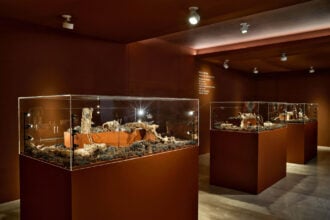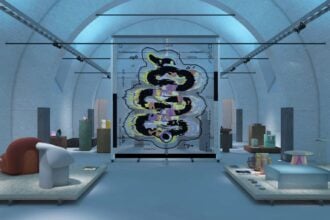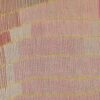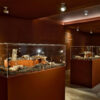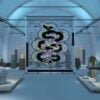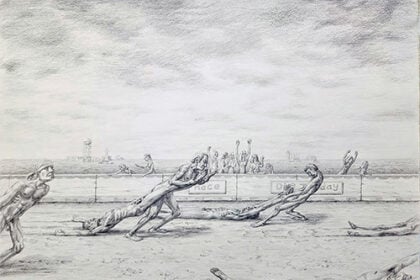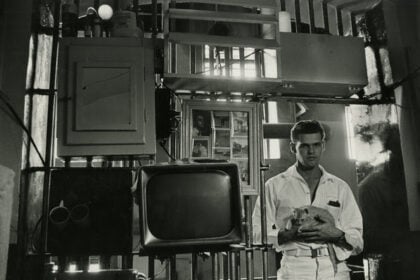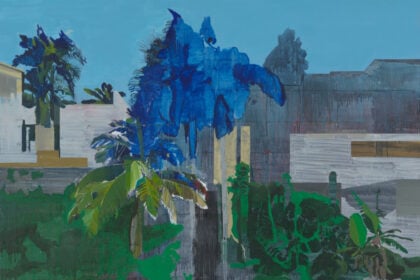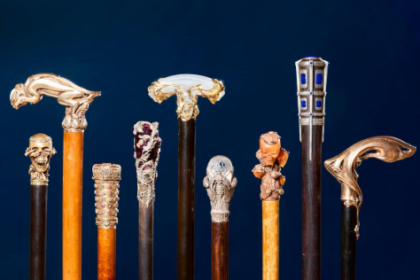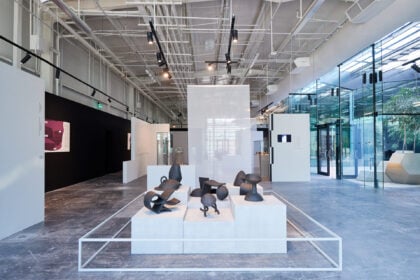Pace is pieased to announce lnner Cosmos, Outer Universe, a group exhibition showcasing works from across the gallery’s international programme by artists that share a fascination with space, from cosmological heights to the molecular foundations of the self. Running from March 15 to May 4, this exhibition will include over thirty paintings, sculptures, textiles, and works on paper, all of which investigate-at sorne level-structures of being and nothingness.
Spanning over eight decades of artmaking, the works in /nner Cosmos, Outer Universe encompass a broad range of artistic responses to the celestial imagination over the past century, both literally and metaphorically. Recalling the polished chrome and sleek surfaces of space-age design, the exhibition will include sculptures by Alexander Calder, Jeff Koons, Alicja Kwade, and Leo Villareal. Chromatic eruptions course through works by Latifa Echakhch, Sonia Gomes, Hermann Nitsch, Richard Pousette-Dart, and Lucas $amaras, suggesting nebulae that refract spectrums of speckled colour. Other, more oblique references to the cosmos recur in works by Torkwase Dyson, Adolph Gottlieb, Matthew Day Jackson, Robert Longo, Robert Rauschenberg, Arlene Shechet, Kiki Smith, and Mika Tajima, which will also be featured in the show.
Many of the works in /nner Cosmos, Outer Universe are united by the formal motif of the circle. This simple geometric shape, which can be found depicted in visual art from pre-historie sites across the globe, commonly signifies the infinite and cyclical nature of existence. Yet it also figures in pictorial depictions of basic elements invisible to the human eye: molecules, for example, and the atoms that form them are typically represented as spherical clusters.
Richard Pousette-Dart’s $pace Continuum, Part 11 (1989), featured in the exhibition, is composed of fields of the artist’s characteristic pointillist marks that coalesce into kaleidoscopic arrangements of whorls and shapes suggestive of stellar clusters, at once atomic and celestial. Monochromatic circles resurface in works by both Adolph Gottlieb, in Untitled (1966), and Robert Longo, in Untitled (After Malevich, Circle – 1915) (2008), underscoring the salience of the form of the circle to the history of Modernist pictorialism. Meanwhile, the circular canvas ofTorkwase Dyson’s (Bird and Lava #03) (2021)-whose interna! geometry refers to the huiIs of ships that carried enslaved peoples across the Atlantic Ocean-proposes the possibility that utopías of liberation might emerge from new formulations of space, shape, and geometry.
Sculptural works in lnner Cosmos, Outer Universe bridge the effervescence of the celestial with the solidity of geology. In Kiki Smith’s Standing Stars 11 (2013), seven- and nine-pointed stars burst skyward from a bronze base. Sungrazer I (2018), also by Smith, depicts a shooting star in earthy hues, with single stalks of wheat cast on its surface as if emerging from the soil itself. Openings in Mika Tajima’s Pranayama (Monolith, K, Rose Quartz) (2023), determined by applying the logic of acupuncture to sculpture, create channels in the piezoelectric material that suggest the spiritual practice of ‘opening’ the body to flows of energy and breath. These works, while substantial in their physical presence, undergo both material and conceptual transformations at the hands of the artist, inviting contemplation on the interplay between materiality and ephemerality.
Jeff Koons’s Gazing Ba/1 (Bottlerack) (2016) invites viewers to inhabit the contemplative depths of reflection, meditating on their own place within the cosmic expanse, and becoming part of the artwork in the process. Meanwhile, Alicja Kwade’s monumental sculpture Continuum (2023) visualizes three spacetime wormholes within a cresting wave, enclosing four sodalite spheres. Here, the ultramarine mineral is veined in cloudy white and chartreuse patches, its polished surface reminiscent of The Blue Marble-the iconic photograph of Earth taken from the Apollo 17 spacecraft en route to the moon. Proposing terrestrial and interstellar sites as a coherent, progressive whole, Kwade’s Continuum gracefully navigates the boundary between the familiar and the enigmatic.
Pace is a leading international art gallery representing sorne of the most influential contemporary artists and estates from the past century, holding decades-long relationships with Alexander Calder, Jean Dubuffet, Barbara Hepworth, Agnes Martín, Louise Nevelson, and Mark Rothko. Pace enjoys a unique U.S. heritage spanning East and West coasts through its early support of artists central to the Abstract Expressionist and Light and Space movements.
Since its founding by Arne Glimcher in 1960, Pace has developed a distinguished legacy asan artist-first gallery that mounts seminal historical and contemporary exhibitions. Under the current leadership of CEO Marc Glimcher, Pace continues to support its artists and share their visionary work with audiences worldwide by remaining at the forefront of innovation. Now in its seventh decade, the gallery advances its mission through a robust global program-comprising exhibitions, artist projects, public installations, institutional collaborations, performances, and interdisciplinary projects. Pace has a legacy in art bookmaking and has published over five hundred titles in close collaboration with artists, with a focus on original scholarship and on introducing new voices to the art historical canon.
Today, Pace has seven locations worldwide, including European footholds in London and Geneva as well as Berlín, where the gallery established an office in 2023. Pace maintains two galleries in New York-its headquarters at 540 West 25th Street, which welcomed almost 120,000 visitors and programmed 20 shows in its first six months, and an adjacent 8,000 sq. ft. exhibition space at 510 West 25th Street. Pace’s long and pioneering history in California includes a gallery in Palo Alto, which was open from 2016 to 2022. Pace’s engagement with Silicon Valley’s technology industry has hada lasting impact on the gallery ata global level, accelerating its initiatives connecting art and technology as well as its work with experiential artists. Pace consolidated its West Coast
activity through its flagship in Los Angeles, which opened in 2022. Pace was one ofthe first international galleries to establish outposts in Asia, where it operates permanent gallery spaces in Hong Kong and Seoul, along with an office and viewing room in Beijing. In 2024, Pace will open its first gallery space in Japan in Tokyo’s new Azabudai Hills development.


